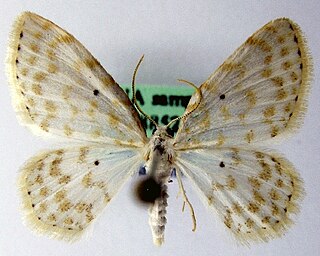
Weevils are beetles belonging to the superfamily Curculionoidea, known for their elongated snouts. They are usually small – less than 6 mm in length – and herbivorous. Approximately 97,000 species of weevils are known. They belong to several families, with most of them in the family Curculionidae. It also includes bark beetles, which while morphologically dissimilar to other weevils in lacking the distinctive snout, is a subfamily of Curculionidae. Some other beetles, although not closely related, bear the name "weevil", such as the biscuit weevil, which belongs to the family Ptinidae.

The dusky moorhen is a bird species in the rail family and is one of the eight extant species in the moorhen genus. It occurs in India, Australia, New Guinea, Borneo and Indonesia. It is often confused with the purple swamphen and the Eurasian coot due to similar appearance and overlapping distributions. They often live alongside birds in the same genus, such as the Tasmanian nativehen and the common moorhen.

Entomophagy in humans or human entomophagy describes the consumption of insects (entomophagy) by humans in a cultural and biological context. The scientific term used in anthropology, cultural studies, biology and medicine is anthropo-entomophagy. Anthropo-entomophagy does not include the eating of arthropods other than insects such as arachnids and myriapods, which is defined as arachnophagy.

The scarlet skimmer or ruddy marsh skimmer, Crocothemis servilia, is a species of dragonfly of the family Libellulidae, native to east and southeast Asia and introduced to Jamaica, Florida, and Hawaii.

Prostomidae is a family of beetles with no vernacular common name, though recent authors have coined the name jugular-horned beetles. They are often found in dead wood. The family consist of two extant genera with about 20 species. Prostomis americanus is known from North America. Other species of Prostomis are found in Europe, Africa, the Pacific region and East Asia. Species of Dryocora are known from New Zealand, Australia and Tasmania.

Lethocerus indicus is a giant water bug in the family Belostomatidae, native to South and Southeast Asia, as well as southeast China, the Ryukyu Islands, and New Guinea. It was originally described as Belostoma indicum but is no longer placed in that genus.

Lucanus maculifemoratus is a beetle of the family Lucanidae. This species is known as Miyama stag beetle in Japan. These beetles have a light covering of golden hair on their back, mostly around the rear edges.

Bamboo shoots or bamboo sprouts are the edible shoots of many bamboo species including Bambusa vulgaris and Phyllostachys edulis. They are used as vegetables in numerous Asian dishes and broths. They are sold in various processed shapes and are available in fresh, dried, and canned versions.
Dorcus tenuihirsutus is a beetle species of the family Lucanidae described from Korea in 2010 by Sang Il Kim and Jin-Ill Kim.

Asthena anseraria is a moth of the family Geometridae. It is known from most of Europe, east to Korea.
Pasiphila excisa is a moth in the family Geometridae. It was described by Arthur Gardiner Butler in 1878. It is found in Russia, Japan and Korea.
Asthena nymphaeata is a moth in the family Geometridae first described by Otto Staudinger in 1897. It is found in the Russian Far East, Korea Japan and China.

Orthotylus is a genus of bugs from the family Miridae. There are more than 300 described species worldwide. The sheer number of species has led to the recognition of subgenera and groups, some of which may be promoted to genus level. Yamsunaga recognized the genus as non-monophyletic, and without consistent diagnostic characteristics.
Asiagomphus cuneatus is a clubtail dragonfly whose naiads are commonly eaten in parts of Yunnan, China. The species was first described by Needham in 1930.

Some species of jellyfish are suitable for human consumption and are used as a source of food and as an ingredient in various dishes. Edible jellyfish is a seafood that is harvested and consumed in several East and Southeast Asian countries, and in some Asian countries it is considered to be a delicacy. Edible jellyfish is often processed into a dried product. Several types of foods and dishes may be prepared with edible jellyfish, including salads, sushi, noodles, and main courses. Various preparation methods exist.

The genus Oxytate, commonly known as grass crab spiders, comprises a homogenous group of nocturnal crab spiders. The complete mitochondrial genome of the type species O. striatipes was determined in 2014.

Aetalionidae are a family of treehoppers in the superfamily Membracoidea. Aetalionidae are somewhat like Membracidae in that they have one to three rows of short spines on the hind tibia but differ in having the front femur fused to the trochanter and the scutellum is completely exposed. The females have finger-like protrusions on the genital capsule. The family is mostly Neotropical. The subfamily Biturritiinae is Neotropical while the subfamily Aetalioninae has a Neotropical genus Aetalion and the sole Old World representative genus Darthula with a single species Darthula hardwickii.

Ceropria induta is a species of darkling beetle native to Asia. It is commonly found in Japan, Korea, southern China to Assam, Sri Lanka and towards islands of Indonesia and the Philippines. There is a sporadic appearance of the species from southern Florida, USA and Macau regions.

Entomophagy is the practice of eating insects. An alternative term is insectivory. Terms for organisms that practice entomophagy are entomophage and insectivore.















